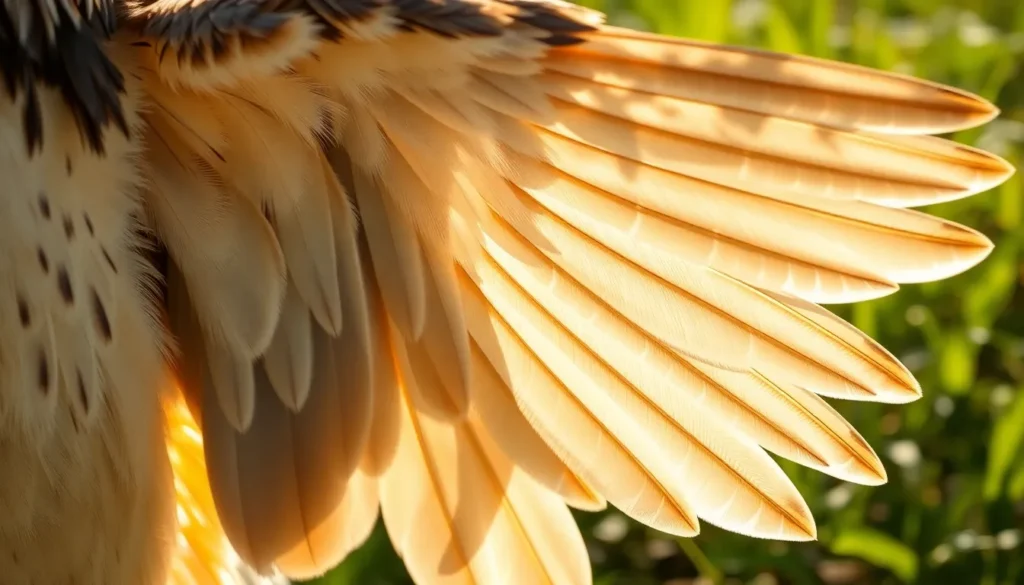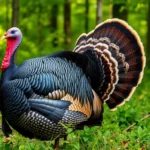Bird wings represent one of nature’s most remarkable engineering marvels. We’ve all watched birds soar effortlessly through the sky but rarely consider the incredible complexity behind their flight capabilities. From the tiniest hummingbird to the massive albatross these magnificent structures showcase millions of years of evolutionary perfection.
Understanding how bird wings work opens up a intriguing area of aerodynamics anatomy and adaptation. We’ll explore the intricate design features that allow different species to master everything from rapid acceleration to long-distance gliding. Each wing type tells a unique story of survival and specialization.
Whether you’re a bird enthusiast curious about flight mechanics or simply amazed by nature’s ingenuity we’re about to dive deep into the secrets of avian flight. The science behind bird wings reveals principles that have inspired human aviation and continue to influence modern aircraft design. Let’s uncover what makes these natural flying machines so extraordinary.
Anatomy of Bird Wings
Bird wing anatomy represents one of nature’s most sophisticated flight systems. We examine the intricate structures that transform simple arm bones into powerful flying machines.
Wing Structure and Components
Bird wings consist of three primary sections that mirror the human arm structure. The humerus forms the upper arm section, connecting the wing to the bird’s body through the shoulder joint. Radius and ulna bones create the forearm segment, while the hand section contains fused finger bones called the carpometacarpus.
Flight muscles attach to these bones through specialized tendons. The pectoralis major provides the powerful downstroke motion, comprising up to 35% of a bird’s total body weight in strong fliers like hummingbirds. Supracoracoideus muscles execute the upstroke through a unique pulley system that routes tendons over the shoulder joint.
Wing coverts form protective layers over the flight surfaces. These small feathers create smooth airflow transitions between different wing sections. Alula feathers act as thumb-like projections that help birds maintain control during slow flight and landing maneuvers.
Feather Types and Functions
Primary feathers generate most of the wing’s thrust and lift forces. These 9-12 large feathers attach to the hand bones and create the wing’s outer edge. Each primary feather can move independently, allowing precise flight adjustments.
Secondary feathers provide lift along the wing’s inner section. Typically numbering 15-25 per wing, these feathers attach to the ulna bone. They maintain wing shape during different flight phases and contribute significantly to overall lift production.
Contour feathers create the wing’s aerodynamic surface. These feathers overlap like roof shingles to form a continuous flight surface. Their barbule structures lock together through microscopic hooks, maintaining feather integrity during flight stresses.
Down feathers provide insulation beneath the flight feathers. Though not directly involved in flight mechanics, these feathers help maintain optimal body temperature for sustained flight performance.
Bone Structure and Adaptations
Hollow bones reduce wing weight while maintaining structural strength. Bird wing bones contain internal struts called trabeculae that provide support similar to airplane wing ribs. This pneumatic bone structure can reduce bone weight by up to 50% compared to solid bones.
Fused hand bones create rigid flight surfaces. The carpometacarpus bone results from evolutionary fusion of several finger bones, eliminating joint flexibility that would compromise flight efficiency. This fusion concentrates flight stresses across a broader surface area.
Specialized joint structures enable complex wing movements. The wrist joint allows wings to fold completely against the body when not flying. Shoulder joints permit the full range of motion required for different flight styles, from hovering to high-speed diving.
Bone density varies across different wing sections. Areas experiencing high flight stresses, such as primary feather attachment points, contain denser bone material. Wing tip bones often show additional reinforcement to handle the extreme forces generated during rapid flight maneuvers.
Types of Bird Wings

Bird wings exhibit four distinct configurations that determine flight characteristics and performance capabilities. Each wing type represents evolutionary adaptations to exact ecological niches and flight requirements.
High Aspect Ratio Wings
High aspect ratio wings feature long, narrow proportions that maximize lift efficiency while minimizing drag forces. Albatrosses exemplify this wing design with spans reaching 11 feet and widths of only 8 inches at their broadest point. Gliding specialists like petrels and shearwaters possess these wings to exploit oceanic wind patterns for extended soaring flights.
Wing loading remains low in high aspect ratio designs, typically ranging from 0.4 to 0.8 pounds per square foot. This configuration generates superior lift to drag ratios of 15:1 or higher compared to other wing types. Ocean dwelling birds use these wings to cover thousands of miles with minimal energy expenditure during migration periods.
Low Aspect Ratio Wings
Low aspect ratio wings display short, broad characteristics that provide exceptional maneuverability and rapid acceleration capabilities. Raptors such as hawks and falcons demonstrate this wing structure with spans often less than 3 times their chord width. Forest dwelling species benefit from these compact wings when handling through dense vegetation and tight spaces.
Acceleration rates in low aspect ratio wing birds reach 4 to 6 times faster than their high aspect ratio counterparts. Wing loading increases substantially in these designs, ranging from 1.2 to 2.5 pounds per square foot. Quick takeoff abilities and sharp turning radius make these wings ideal for hunting prey in confined environments.
Elliptical Wings
Elliptical wings combine balanced proportions that optimize both efficiency and maneuverability for diverse flight requirements. Songbirds including robins, sparrows, and finches showcase this versatile wing shape across multiple habitats. Rounded wingtips reduce drag while maintaining adequate lift generation for sustained flight performance.
Aspect ratios in elliptical wings typically measure between 4:1 and 6:1, providing moderate wing loading characteristics. These wings excel in short distance flights while retaining enough efficiency for seasonal migrations. Passerine species rely on elliptical wing designs to perform complex aerial maneuvers during territorial displays and predator evasion.
Swept Wings
Swept wings angle backward from the body to reduce drag at higher flight speeds while maintaining structural stability. Swifts and some falcon species demonstrate pronounced wing sweep angles reaching 45 degrees or greater. This configuration enables birds to achieve sustained high speed flight exceeding 60 miles per hour during hunting or migration activities.
Aerodynamic efficiency improves significantly in swept wing designs at velocities above 40 miles per hour. Wing tips experience reduced air turbulence due to the backward angled configuration. Fast flying insectivores like swifts use swept wings to capture prey during high speed aerial pursuits while maintaining precise flight control.
Wing Mechanics and Flight Patterns
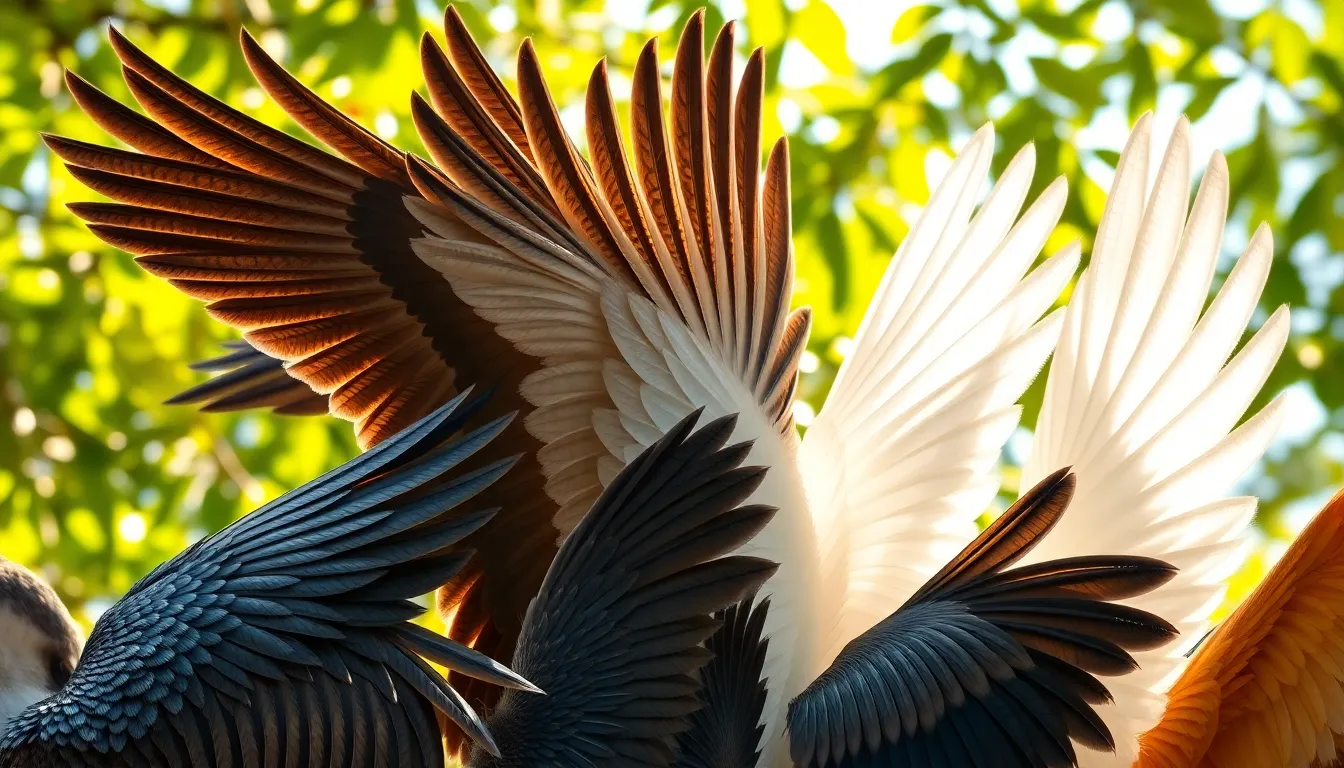
Bird wing mechanics transform structural adaptations into sophisticated flight patterns through precise aerodynamic control. We observe how different species leverage their wing designs to achieve optimal performance across various flight scenarios.
Flapping Flight Dynamics
Flapping flight mechanics involve complex interactions between wing beat frequency, amplitude, and angle of attack during each stroke cycle. Primary flight feathers generate thrust through a figure-eight motion pattern, creating forward propulsion while secondary feathers maintain lift stability. Hummingbirds demonstrate extreme flapping dynamics with wing beat frequencies reaching 80 beats per second, enabling hovering capabilities through specialized shoulder joint rotations.
Wing stroke patterns vary significantly among species based on their flight requirements and wing morphology. Songbirds use a shallow stroke angle of 30-40 degrees for efficient forward flight, while raptors employ deeper stroke angles of 60-90 degrees during takeoff and landing phases. Muscle contractions coordinate precisely with wing positioning to optimize lift generation throughout each flapping cycle.
Power requirements for flapping flight increase exponentially with body size, explaining why larger birds rely more heavily on soaring techniques. Small passerines maintain continuous flapping flight for extended periods due to their favorable power-to-weight ratios, while larger species like pelicans alternate between powered flapping and gliding phases to conserve energy.
Soaring and Gliding Techniques
Soaring flight exploits atmospheric conditions to maintain altitude without continuous wing flapping, significantly reducing energy expenditure during long-distance travel. Thermal soaring utilizes rising columns of warm air, allowing birds like hawks and eagles to gain altitude while circling within these updrafts. Ridge soaring takes advantage of wind deflection over hills and mountains, creating upward air currents that support sustained flight.
Ever-changing soaring represents the most sophisticated aerial technique, practiced by albatrosses and other seabirds over ocean surfaces. These birds exploit wind speed gradients between air layers, gaining energy from wind shear differences to maintain flight for hours without flapping. Albatrosses achieve glide ratios exceeding 20:1, meaning they travel 20 meters horizontally for every meter of altitude lost.
Slope soaring enables birds to maintain position relative to moving air masses, particularly effective along coastlines and mountain ranges where consistent wind patterns develop. Vultures demonstrate exceptional thermal detection abilities, identifying rising air columns from distances exceeding 10 kilometers through visual observation of other soaring birds and environmental cues.
Wing Loading and Performance
Wing loading measures the relationship between body weight and wing area, directly influencing flight performance characteristics across different species. Low wing loading values below 5 grams per square centimeter characterize agile forest birds like warblers, enabling quick acceleration and maneuvering through dense vegetation. High wing loading values above 15 grams per square centimeter typify fast-flying species like ducks and shorebirds, supporting efficient long-distance migration flights.
Flight speed correlations with wing loading demonstrate predictable patterns across bird families, with higher wing loading generally corresponding to increased minimum flight speeds. Waterfowl maintain wing loading values between 12-18 grams per square centimeter, requiring higher takeoff speeds but achieving superior flight efficiency during sustained travel. Raptors exhibit moderate wing loading values of 6-12 grams per square centimeter, balancing maneuverability requirements with soaring capabilities.
Wing aspect ratio interactions with loading characteristics determine exact flight performance parameters for each species. High aspect ratio wings combined with moderate wing loading, seen in albatrosses, maximize gliding efficiency and range capabilities. Low aspect ratio wings paired with low wing loading, exemplified by forest hawks, optimize turning radius and acceleration performance in confined spaces.
Evolutionary Development of Bird Wings
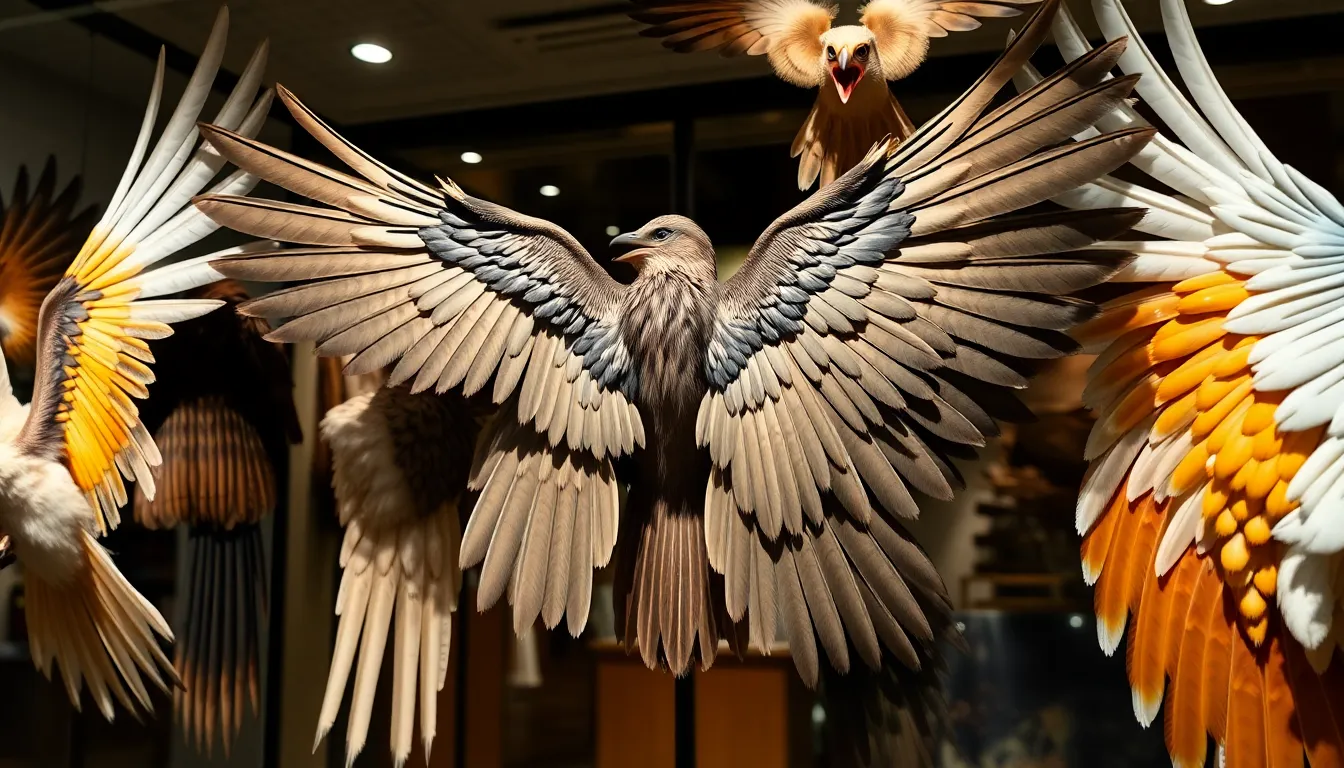
Bird wings represent one of evolution’s most remarkable innovations, transforming over 150 million years from simple dinosaur forelimbs into sophisticated flight instruments. We trace this extraordinary journey through fossil records and genetic studies that reveal how wings evolved through gradual modifications and environmental pressures.
From Dinosaurs to Modern Birds
Theropod dinosaurs developed the earliest wing-like structures around 160 million years ago, with species like Archaeopteryx displaying primitive feathers and basic wing anatomy. Fossil evidence shows that Microraptor possessed four wings with asymmetrical flight feathers, indicating that early wing evolution experimented with different configurations before settling on the two-wing design.
Feather evolution preceded flight by approximately 50 million years, initially serving thermoregulatory and display functions in dinosaur species. Sinosauropteryx fossils reveal simple filamentous proto-feathers that gradually developed into complex branched structures through successive evolutionary stages.
Wing bone modifications occurred through systematic changes in theropod skeletal architecture over millions of years. The furcula (wishbone) strengthened to anchor powerful flight muscles, while finger bones fused into the rigid carpometacarpus structure that supports primary flight feathers. Pneumatization of bones reduced skeletal weight by 20-30% compared to solid bone structures.
Modern bird wings emerged during the Cretaceous period through refinements in feather asymmetry, joint flexibility, and muscle attachment points. Genetic studies identify key regulatory genes like Tbx5 and Pitx1 that controlled wing development patterns, creating the blueprint for contemporary avian wing architecture.
Adaptation to Different Environments
Arctic environments shaped wing adaptations in species like snowy owls, which developed broader wings with specialized feather structures that reduce heat loss during flight. These wings feature dense down underlayers and modified primary feathers that minimize turbulence in cold air conditions.
Desert habitats influenced wing evolution in species such as sandgrouse, creating wings optimized for efficient long-distance water collection flights. Wing loading values of 8-12 N/m² enable these birds to cover hundreds of kilometers while carrying water-soaked belly feathers back to their chicks.
Forest environments produced elliptical wing shapes in songbirds, thrushes, and woodpeckers that navigate dense vegetation with precise maneuvering capabilities. Wing aspect ratios of 4-6 provide optimal balance between lift generation and obstacle avoidance in cluttered habitats.
Marine environments drove the evolution of high aspect ratio wings in seabirds like petrels and shearwaters, with ratios reaching 12-15 for maximum gliding efficiency over ocean surfaces. Salt glands and specialized feather waterproofing evolved alongside wing modifications to support extended oceanic flight periods.
Mountain habitats created wing adaptations in raptors and vultures that exploit thermal updrafts for energy-efficient soaring. Wing spans of 2-3 meters combined with slotted primary feathers reduce wingtip vortices, enabling these birds to remain airborne for 6-8 hours without flapping.
Grassland ecosystems influenced wing development in ground-nesting birds like larks and pipits, producing wings capable of rapid vertical takeoffs and sustained hovering for territorial displays. Wing beat frequencies of 15-20 Hz generate sufficient lift for vertical ascension from ground level.
Wing Variations Across Bird Species

Wing design varies dramatically among bird species, reflecting millions of years of specialized evolution. Each species displays unique wing characteristics optimized for their exact hunting methods, habitat requirements, and flight demands.
Raptors and Hunting Adaptations
Raptors possess wing structures perfectly engineered for predatory success through exceptional maneuverability and strike precision. Hawks demonstrate broad wings with deeply slotted primaries that create individual airfoils, reducing wingtip turbulence during tight turns while pursuing prey through dense vegetation. Falcons showcase swept-back wings with pointed tips that minimize drag during high-speed dives, with peregrine falcons achieving speeds exceeding 240 mph during hunting stoops.
Eagles use large wing surfaces with extensive slotting between primary feathers, generating powerful lift for carrying prey weighing up to 15 pounds while maintaining stable flight. Owls feature specialized wing adaptations including soft-fringed feather edges and flexible down that eliminates sound during flight, creating virtually silent approaches to unsuspecting prey. Kestrels display narrow wings optimized for hovering efficiency, allowing sustained stationary flight while scanning ground surfaces for small mammals and insects.
Seabirds and Long-Distance Flight
Seabirds exhibit wing designs maximizing energy efficiency during extended oceanic journeys spanning thousands of miles without rest. Albatrosses possess the highest wing aspect ratios among all birds, with wandering albatrosses displaying wingspans reaching 11.5 feet that generate exceptional lift-to-drag ratios for ever-changing soaring across ocean winds. Shearwaters demonstrate narrow wings with reduced wing loading that enables efficient gliding just above wave surfaces, utilizing ground effect aerodynamics to minimize energy expenditure.
Petrels feature tube-shaped nostrils integrated with specialized wing positioning that enhances their ability to detect scent trails across vast ocean distances while maintaining stable flight patterns. Gannets display pointed wing tips and reinforced bone structures supporting high-impact diving from heights exceeding 100 feet into ocean waters at speeds reaching 60 mph. Frigatebirds showcase extremely lightweight wing construction with hollow bones comprising less than 5% of total body weight, creating the lowest wing loading values among seabirds for effortless soaring above tropical waters.
Hummingbirds and Hovering Abilities
Hummingbirds possess unique wing mechanics enabling sustained hovering flight through revolutionary adaptations not found in other bird species. Their wings rotate at the shoulder joint through nearly 180 degrees, creating lift during both upstroke and downstroke phases unlike conventional bird flight patterns. Ruby-throated hummingbirds generate wingbeat frequencies reaching 80 beats per second, producing the characteristic humming sound while maintaining precise positional control during nectar feeding.
Bee hummingbirds display the most extreme miniaturization adaptations, weighing just 1.6 grams while maintaining wing aspect ratios optimized for hovering efficiency in confined spaces among dense flower clusters. Giant hummingbirds demonstrate how larger species modify wing loading characteristics, beating wings at 10-15 beats per second compared to smaller species while maintaining equivalent hovering capabilities through increased wing surface area. Anna’s hummingbirds showcase specialized flight muscle composition comprising 25-30% of total body mass, providing the extraordinary power output required for sustained hovering and rapid acceleration reaching 27 mph during territorial displays.
Wing Care and Maintenance in Birds
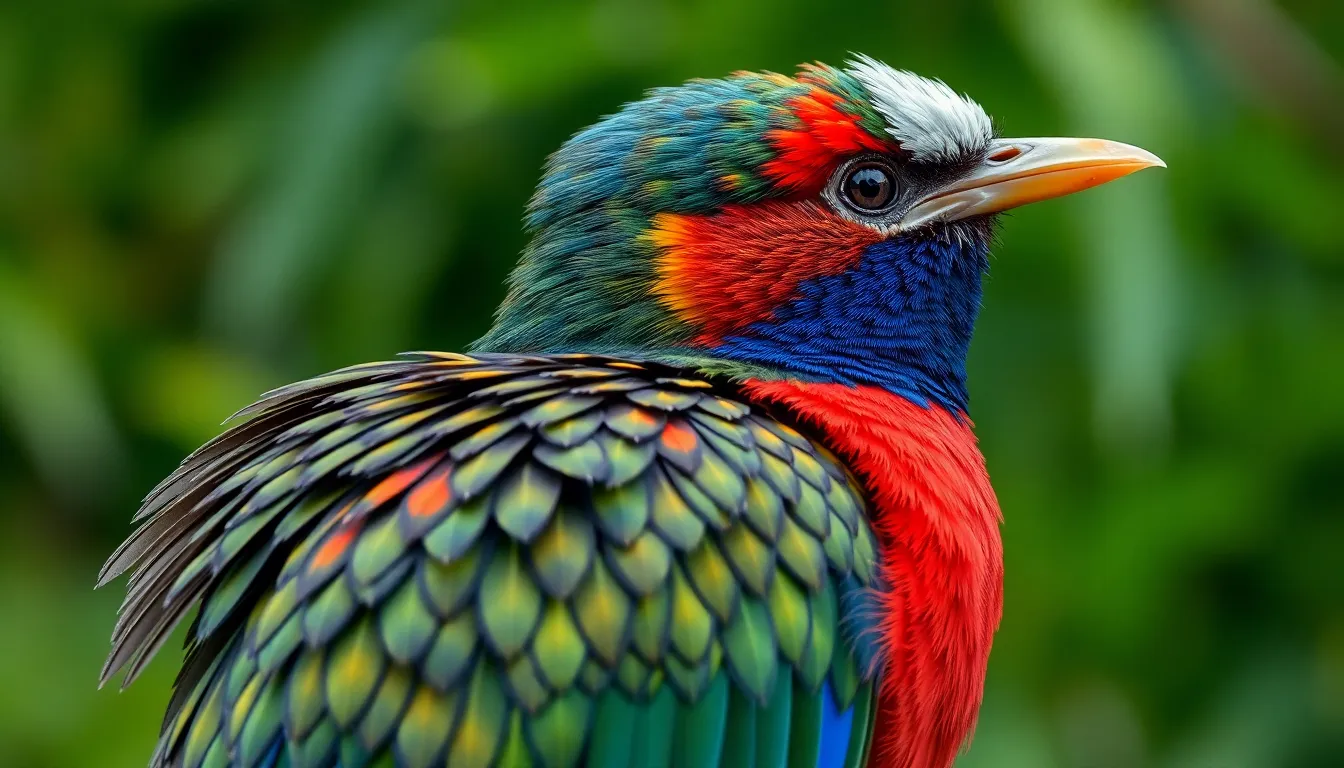
Birds invest considerable time maintaining their wing structures to preserve optimal flight performance. These maintenance behaviors ensure feathers remain properly aligned and flight capabilities stay intact across seasonal changes.
Preening and Feather Health
Preening represents the primary maintenance behavior birds use to keep their wing feathers in peak condition. Birds spend 15-30% of their daily active hours engaged in preening activities according to ornithological studies. The process involves using their beaks to realign feather barbules that become separated during flight or other activities.
Oil distribution from the uropygial gland plays a crucial role in wing maintenance. Located near the base of their tails, this gland produces waterproofing oils that birds spread across their feathers during preening. Waterfowl like ducks and geese rely heavily on this oil to maintain their flight feathers’ water resistance.
Different species exhibit specialized preening techniques based on their wing structures:
- Raptors use their powerful beaks to carefully maintain primary flight feathers
- Hummingbirds perform rapid preening motions to keep their delicate wing surfaces clean
- Seabirds engage in extensive preening sessions after exposure to salt water
- Songbirds focus on maintaining the alignment of their elliptical wing feathers
Wing stretching exercises accompany preening behaviors in most bird species. These stretching motions help maintain joint flexibility and muscle tone essential for effective wing movement. Birds typically perform these exercises multiple times throughout the day.
Molting Cycles
Molting cycles determine when birds systematically replace their flight feathers to maintain wing functionality. Most bird species undergo complete wing molts annually, though timing varies significantly based on migration patterns and breeding schedules.
Primary flight feather replacement follows exact sequences across different bird groups. Songbirds typically replace their primaries in sequential order from the innermost feather outward over 6-8 weeks. Waterfowl shed all their flight feathers simultaneously, rendering them temporarily flightless for 3-4 weeks during summer months.
| Bird Group | Molt Duration | Flight Impact | Timing |
|---|---|---|---|
| Songbirds | 6-8 weeks | Minimal | Post-breeding |
| Waterfowl | 3-4 weeks | Complete flightlessness | Mid-summer |
| Raptors | 4-6 months | Gradual reduction | Year-round |
| Seabirds | 2-4 months | Partial limitation | Post-breeding |
Energy requirements during molting periods increase substantially as birds produce new feather proteins. Studies show metabolic rates can increase by 25-40% during active feather replacement phases. Birds often reduce their activity levels and seek nutrient-rich food sources during these periods.
Molt timing synchronizes with environmental conditions and life cycle events. Arctic breeding birds complete their molts before migration, while resident species may spread molting over longer periods. Breeding adults typically delay major wing molts until after their reproductive responsibilities end.
Partial molts occur between complete annual cycles in many species. These partial molts replace worn contour feathers and some secondary flight feathers without affecting primary flight capabilities. Young birds experience their first complete wing molt at 12-18 months of age depending on species maturation rates.
Conclusion
We’ve explored the incredible engineering marvel that is the bird wing – from its intricate anatomy and evolutionary origins to the diverse adaptations that define modern avian flight. These remarkable structures represent millions of years of natural selection working to perfect the art of aerial locomotion.
The ongoing maintenance behaviors we’ve examined demonstrate just how crucial wing care is for survival. Birds dedicate enormous energy to preening and molting cycles because their lives literally depend on optimal wing performance.
Understanding bird wings continues to inspire human innovation in aviation and engineering. As we develop new technologies we often look to these natural masters of flight for answers to our own aerodynamic challenges.
The next time you see a bird in flight remember the sophisticated biological machinery at work. Every wingbeat represents a perfect symphony of bone structure muscle coordination and feather dynamics that we’re still working to fully comprehend and replicate.
Frequently Asked Questions
What are the main parts of a bird wing’s anatomy?
Bird wings consist of three primary bone sections: the humerus (upper arm), radius and ulna (forearm), and carpometacarpus (fused hand bones). These are powered by specialized flight muscles and covered with different types of feathers including primary, secondary, contour, and down feathers. The bones are hollow to reduce weight while maintaining strength for flight.
What are the four main types of bird wings?
The four main wing types are high aspect ratio (long and narrow like albatrosses for efficient gliding), low aspect ratio (short and broad like hawks for maneuverability), elliptical (balanced proportions like songbirds for versatility), and swept wings (angled back like swifts for high-speed flight). Each design serves specific flight requirements and ecological niches.
How do bird wings generate lift and enable flight?
Bird wings generate lift through complex aerodynamic principles involving wing beat frequency, amplitude, and angle of attack. The curved wing shape creates different air pressures above and below the wing. Specialized joint structures allow intricate wing movements, while the interaction between flapping dynamics and wing loading determines flight performance and efficiency.
How have bird wings evolved over time?
Bird wings evolved from dinosaur forelimbs over 150 million years ago. Early theropod dinosaurs developed wing-like structures and primitive feathers. Through gradual evolution, these structures became sophisticated flight instruments with modified bone structures, specialized feathers, and adaptations to various environments like forests, deserts, mountains, and marine habitats.
How do birds maintain their wings for optimal flight performance?
Birds spend 15-30% of their active hours preening to maintain wing structures. This involves realigning feather barbules and distributing waterproofing oils from the uropygial gland. Birds also undergo molting cycles to systematically replace flight feathers, which requires increased energy and typically synchronizes with environmental conditions and breeding cycles.
What is wing loading and how does it affect bird flight?
Wing loading is the relationship between a bird’s body weight and wing area. Low wing loading characterizes agile forest birds that need quick maneuverability, while high wing loading supports efficient long-distance migration in species like ducks. This measurement, combined with wing aspect ratio, determines each species’ specific flight performance capabilities.
How do different bird species adapt their wings to their environment?
Bird species have evolved specialized wing adaptations for their specific habitats. Raptors have wings optimized for predatory maneuverability, seabirds possess designs for energy-efficient long-distance flights, and hummingbirds feature unique mechanics for sustained hovering. These adaptations reflect millions of years of evolution tailored to hunting methods, habitat requirements, and flight demands.

